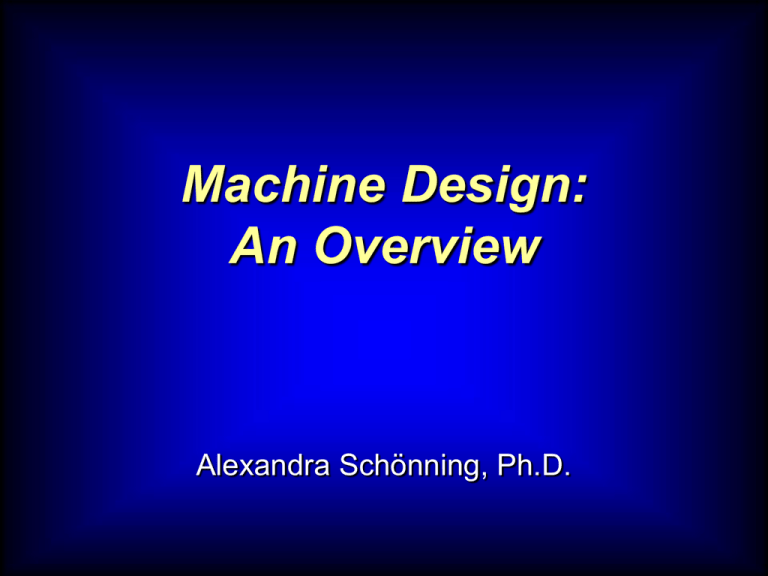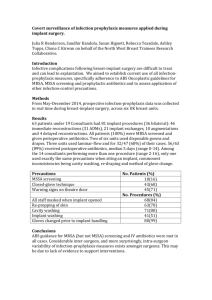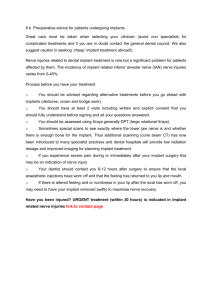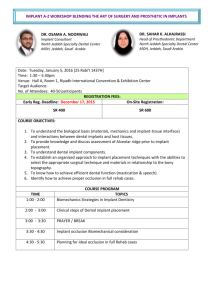What is machine design
advertisement

Machine Design: An Overview Alexandra Schönning, Ph.D. Presentation Outline Introduction: What is Machine Design? Machine Design: Research Areas Research Applications: – Gear Tooth FEM/FEA and Optimization – Machine Design Optimization – Customized Knee Implant: Design, Stress Analysis and Manufacturing Introduction: What is Machine Design? Core of mechanical engineering – – – – Stress and strain Designing for safety Static failure theories Fatigue failure theories – Machine elements – Mechanical material properties – Stress Concentrations – Fracture Mechanics – Optimization – Composite Materials – Manufacturing Processes – Computer Aided Machine Design and Analysis – Measuring Stress and Strain Introduction: Stress and Strain σy Stress and strain τxy – Normal stresses and strains σx θ – Shear stresses and strains – Principal stresses and strains – Mohr’s circle and analytical relationships τ 1, 2 σ3 σ2 σ1 σ x y 2 max ( ( x y 2 x y 2 tan( 2 ) ) 2 xy2 2 xy x y ) 2 xy2 Introduction: Static Failure Ductile Behavior – Maximum Shear-Stress Theory Sy σ1 σ 3 FS (Tresca/Coulomb/Guest Theory) – Distortion Energy Theory (von Mises) σ eff Sy 2 (σ1 σ 2 ) 2 (σ 2 σ 3 ) 2 (σ 3 σ1 ) 2 2 FS Brittle Behavior (even and uneven materials) – Coulomb-Mohr Theory -Suc, Sut -Sut, Sut Sut, Sut σ1 τ Sut, -Sut σ Compression test σ3 Tension test uneven Sut, -Sut Introduction: Fatigue Failure Alternating and mean stress Stress-Life Approach – High Cycle Fatigue Criteria – Load amplitude is consistent – Common for rotating machinery Strain-Life Approach – Low cycle fatigue (<103) – Variations in loads and high temperatures – Common for service machinery t 1.0 0.8 0.6 0.4 103 Fracture Mechanics Approach – Low cycle fatigue – Generally used to determine remaining life of a cracked part da n,A: empirical values A (K ) – Paris equation dN K: stress intensity factor n 104 105 106 Corrected endurance limit: Se=CloadCsizeCsurfCtempCreliabSe‘ Corrected fatigue strength Sf=CloadCsizeCsurfCtempCreliabSf' 107 Introduction: Machine Elements Springs Fasteners Bearings Shafts Gears Machined Universal Joint Coiled Machine Design: Research Areas Finite Element Analysis Design Optimization Biomechanics Nanotechnology Fracture Mechanics Mechanical Material Properties Composite Materials Designing for Manufacturing Welding Research Applications: Gear tooth stress analysis and measurement – Typical component studied in machine design Finite element modeling and analysis Stress measurement using polariscope Machine Design Optimization – Improve performance, reduce mass, stress and cost Missile design Optimization theory Customized Knee Implant: – Hinge joint Design to even out stress, remove areas of stress concentration Finite element analysis Manufacturing Gear Tooth: Introduction Gear is a typical component studied in machine design In analyzing the stresses in gears one uses stress/strain and failure theories The stresses were measured using a polariscope Objective: minimize stress at the root of a gear tooth by introducing a stress relief hole Parameters: location (r, θ) and size of hole Analytical model: I-DEAS Master Series – Solid Model, FEA, Optimization, .stl file Experimental analysis to validate analytical model – Stereolithography model, Polariscope Gear Tooth: Two Gears Meshing Gear Tooth: Two Gears Meshing Gear Tooth: Solid Model Creation Involute and gear created in I-DEAS Simplifications: no fillets, one tooth – – – – – – – Pitch Diameter = 360 mm Number of teeth = 30 Pressure angle = 20o Addendum = 12 mm Dedendum = 15 mm Gear thickness = 5 mm Circular tooth thickness = 18.85 mm Gear Tooth: FEA Results: original model – Band of high max principal stress – Max tensile stress – Area of concern Crack propagation Fatigue failure begins at a crack Load Max Tensile Stress Gear Tooth: FEA Mesh – – – – Triangular shell elements With and without hole Partitions Free locals – mesh control Boundary conditions – Cantilever beam approx. Load: along 20o pressure line Gear Tooth: Optimization Objective: Minimize stress Design Variables: – Hole diameter – Angular location – Radial location Constraints – Displacement restraints Algorithm: Fletcher-Reeves optimization algorithm – Gradient based, improved steepest descent method – Xq = Xq-1 + a*Sq Initial search direction is the steepest decent: -F(Xq) Sq = -F(Xq)+qSq-1 q = | F (Xq) |2 / | F (Xq-1) |2 Gear Tooth: Optimized Hole Location θ=29o r = 4 mm diameter =2 mm Gear Tooth: Stereolithography Model Creation Stereolithography machine SLA-250 –Laser cured one layer at a time –Thickness: 0.006 inch (103 layers) –Material: SL5170 –Ultraviolet oven for 45 min Models created in 15 hours –With and without hole Stress Relief Hole Support Structure Boundary Condition Holes Gear Tooth: Experimental Setup Experimental study to verify FEA A flange with holes for mounting was added to the models to hold the parts in place in the polariscope – Compression force was applied – Bracket was used to distribute the force Circular polariscope dark field was used – Used to analyze stress in 2D models Gear Tooth: Circular Polariscope Gear Tooth: Isochromatic Fringes Extinction of light of a particular wave lengths (colored light) Determines the magnitude of the stress difference – n = hc/*(1- 2) n: fringe order hc/: constants 1- 2: stress difference black yellow red | blue yellow red | green yellow red | green yellow red | g y r | ... Gear Tooth: Comparison of Fringes With and Without Hole Gear Tooth: Stress Results 101 kPa 85.7 kPa (15% decrease) Gear Tooth: Deflection Results 12.9 nm 13.2 nm 2.3% difference Gear Tooth: Concluding Remarks Stresses were analyzed and measured for a gear – Stresses decreased by 15%. – Deflection increase of 2.3% has no major effect on the kinematics and functionality of gear. Hole was introduced close to the corner of maximum tensile stress at an angle of 29 degrees from vertical. Photoelasticity results verified the analysis Machine Design Optimization: Optimization of a Missile Designing parts for performance and mass production – – – – – Mass reduction Stress reduction Cost reduction Performance improvement Machine design components or systems Missile design – Optimization theory and application – Academic vs. industrial design optimization Machine Design Optimization: Basics Optimization Vocabulary Minimize F(X) s.t. gj (X) 0 hk(X) = 0 Xilower Xi Xiupper X Description Objective function Inequality Equality constraints Side Design variable vector Multidisciplinary Design Optimization – Computational expense – Organizational complexity 1 Aerodynamic Analysis Geometry Engine Trajectory Analysis 3 2 Aerodynamic coefficients 3 Thrust verses time Specific Impulse Nozzle dimensions 4 Dimensions Volume, Mass Configuration 5 Nozzle exit diameter power on/off 6 Geometric dimensions Propulsion dimensions, Material, Weight 7 Single or dual pulse configuration Propellant weight Cost Analysis 4 Propulsion Analysis Aerodynamic configuration mass properties CG location 6 5 2 1 7 Machine Design Optimization: Basics Optimization Algorithms – Gradient-based Algorithms – Genetic Algorithms MDO Formulations – Discipline communication Approximations – – – – Artificial Neural Networks Design of Experiment Response Surface Approximations Taylor Series Approximations Machine Design Optimization: Algorithms Gradient Based – Sensitivities (gradients) from finite difference – Local minimum – Basic concept u u ( x x) u ( x) x x Xq = Xq-1 + a*Sq X: design vector q: iterate S: Search direction a: distance to move in direction S – Unconstrained problem Gradient is zero Positive definite Hessian Matrix – Constrained problem Khun-Tucker necessary condition X* is feasible jgj (X*) = 0 j = 1,m j 0 F(X*) + Sjgj(X*) + Skhk(X*) = 0 j 0 Machine Design Optimization: Academic vs. Industrial Problems Design Goal – Maximize range Key design parameters – – – – – Mid body diameter Mid body length Nose length Case length Web fraction (difference of the outer and inner radii to the inner radius) – Expansion ratio (the ratio of the exit area to the throat area of the nozzle) – Gamma (angle of the velocity vector) Constraints – – – – – – Weight Center of gravity Total missile length Cost Nose finess ratio Minimum Mach number Machine Design Optimization: Missile Concluding Remarks Algorithms, Formulations, Approximations and programming language were combined to remove obstacles. Optimization scheme was integrated and tested on a highly coupled air-to-air sparrow-like missile – Efficient and robust optimization scheme: Reduced computational time up to 44% Allows for modifications to the optimization statement Covers regions in the design space for which a response cannot be computed Scheme can be applied to other large-scaled engineering problems Knee Implant Example Knee joint is a hinge joint Stress analysis Stress concentrations Wear of the implant Manufacturing – Rapid Prototyping – Investment Casting c Femur Fibula Tibia Patella Knee Implant Example: Need for Customization >0.5 million orthopedic implant surgeries conducted each year in the US – Number increasing Increasing life span Higher activity level Problems associated with implants are proportionally increasing – Use of standard implants leads to removal of valuable bone material – Revisions are primarily due to loosening of implants Poor fit – only a few types and sizes are available Stress concentrations affect bone remodeling Knee Implant Example: Current Design Sharp edges Medial cross section of femoral component Stem Tibial Plateau Cortical Bone Cancellous Bone Knee Implant Example: Current Design Problems with current design: – – – – – – – – Only 7 different sizes Removal of bone Doesn’t fit perfectly Not used for younger patients Sharp edges Stress concentrations Bone remodeling Loosens with time Femoral component Tibial component Knee Implant Example: Design of Customized Implant Designing the customized implant – Implant should resemble the geometry of the original knee – Redistribution of stresses results in variation of bone mineral density – Reduce possible relative motion of tibial plate implant to the tibial bone Data acquisition – Computed Tomography data Modeling of bone and implant Knee Implant Example: Design of Customized Implant CT-data acquisition – Scanning device completes a 360o revolution – Slices are 1 to 5 mm apart – Result: Matrix with gray scaled pixels based on tissue density Knee Implant Example: Design of Customized Implant Data conversion using Mimics from Materialise Density threshold Investigation of each scanned slice Knee Implant Example: Design of Customized Implant Scanning the object Resulting Image Set Slice distance Knee Implant Example: Design of Customized Implant Select the desired region … and Grow Knee Implant Example: Design of Customized Implant Data conversion using Mimics from Materialise Knee Implant Example: Design of Customized Implant Femoral Component Tibial Component Knee Implant Example: Initial Stress Analysis of Implant Finite Element Analysis – 0o, 45o, 90o gait angle – Load 3,5,10 times the body weight Knee Implant Example: Initial Stress Analysis of Implant Knee Implant Example: Initial Stress Analysis of Implant 45o gait 90o gait Knee Implant Example: Initial Stress Analysis of Implant Implant Design (σ in MPa) X*body weight (85kg * 9.81m/s2) 0° gait angle 45° gait angle Old 3 186 150 154 New 3 158 115 130 Old 5 311 250 257 New 5 263 191 217 Old 10 622 500 514 New 10 525 383 435 Type of Implant 90° gait angle Knee Implant Example: Manufacturing Rapid Prototyping –Laser cures one layer at a time –Thickness: 0.006 inch Investment Casting CAD model to stereolithography model. –Eliminates costly low-productionrun wax pattern tooling. Knee Implant Example: Manufacturing – Investment Casting Knee Implant Example: Manufacturing – Investment Casting Knee Implant Example: Manufacturing – Investment Casting Knee Implant Example: Concluding Remarks An implant design has been studied and redesigned to increase life of the implant Initial stress analysis have been performed. – Results are favorable for the new implant Manufacturing of implant – Rapid prototype model – Investment casting model Future work: – Improve finite element model and analysis – Parameterize and optimize Machine design: – Hinge joint, stress analysis, stress concentration, wear, manufacturing Overall Conclusion Machine Design Overview Research Areas and Applications – Gear Tooth FEM/FEA and Optimization – Machine Design Optimization – Customized Knee Implant: Design, Stress Analysis and Manufacturing Research Mission at UNF






